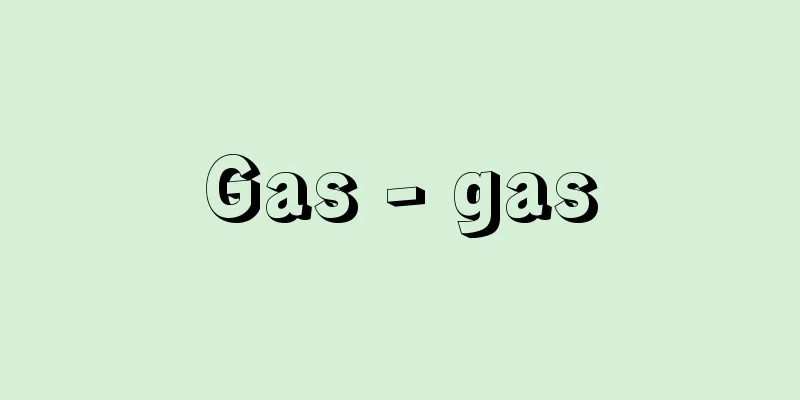Gas - gas

|
It is one of the aggregate states of matter, and is called a fluid along with liquids. It does not have the elasticity, or rigidity, to change shape while keeping the volume constant. Although they are both fluids, gases, unlike liquids, do not have a free surface. Therefore, the volume of a gas is equal to the volume of its container. All types of gases, except when they undergo chemical reactions, do not mix well and do not become two phases like water and oil. Therefore, it is difficult to distinguish whether a gas is a mixture or a pure gas without chemical analysis. Gases are much easier to compress than solids or liquids. The volume and pressure of a gas are inversely proportional to each other when the temperature is kept constant (Boyle's law). Also, when the pressure is kept constant, the volume increases by 1/273 of the volume at 0°C for every 1°C increase in temperature (Charles' law). Combining these, pV=c(t+273) Real gases can be liquefied by appropriate methods. Carbon dioxide (carbonic acid gas), propane, etc. can be liquefied simply by applying pressure, but oxygen, nitrogen, hydrogen, helium, etc. cannot be liquefied no matter how compressed they are at room temperature, so they were once called permanent gases. However, it was discovered that these gases can be liquefied if they are compressed below their respective critical temperatures. Carbon dioxide and propane, mentioned above, have critical temperatures higher than room temperature, so they can be compressed and liquefied at room temperature. Therefore, if it is known that each gas has its own critical temperature, the term permanent gas becomes meaningless. If a gas can be cooled sufficiently, it can be liquefied even at 1 atmosphere. The lowest liquefaction temperature, or boiling point, at 1 atmosphere is helium, which has an absolute temperature of 4.2 K (i.e. minus 269 °C). Such substances are considered to be ideal gases over a wide temperature range. A gas of extremely high density can be called a gas because it has no free surface, but in terms of physical properties it is better to think of it as a liquid. In this way, we can say that when a gas is compressed strongly above the critical temperature, it changes continuously from a gas to a liquid. Unlike previous explanations, the term gas is also used to refer to any system of particles in which interactions can be ignored. The terms Fermi gas and Bose gas are used for systems of fermions and bosons in which interactions can be ignored, and a system of conduction electrons (fermions) in a metal is often called an electron gas. [Shohei Miyahara] [Reference] |Source: Shogakukan Encyclopedia Nipponica About Encyclopedia Nipponica Information | Legend |
|
物質の集合状態の一つで、液体とともに流体とよばれる。それは、体積を一定に保ったまま形を変えるときの弾性すなわち剛性をもっていない。同じ流体とはいっても、気体は液体と違って自由表面をもたない。したがって気体の体積は容器の体積と一致する。気体はどのような種類のものでも、化学反応をおこす場合を別として、まったくよく混じり合い、水と油のように2相になるというものはない。それゆえ、混合気体であるか純粋気体であるかは、化学分析をしなければ区別しがたい。気体は固体や液体と比べてはるかに容易に圧縮することができる。気体の体積と圧力とは、温度を一定に保っておくと互いに反比例する(ボイルの法則)。また圧力を一定に保つと、体積は温度1℃上がるごとに、0℃のときの体積の273分の1ずつ増大する(シャルルの法則)。これを組み合わせると 現実の気体は適当な方法でそれを液化することができる。二酸化炭素(炭酸ガス)、プロパンなどは、単に圧力を加えるだけで液化されるが、酸素、窒素、水素、ヘリウムなどは、常温でどのように圧縮しても液化することができないので、かつては永久気体の名でよばれたこともあった。しかし、それらの気体も、それぞれの臨界温度以下に下げておいて圧縮すれば液化することがわかった。前記の二酸化炭素やプロパンは、その臨界温度が常温より高いので、常温で圧縮して液化することができる。それゆえ、気体にそれぞれ固有の臨界温度があることがわかれば、永久気体ということばは無意味となる。気体を十分冷却することができれば、1気圧でも液化する。1気圧の下での液化温度すなわち沸騰点のもっとも低いのはヘリウムであって、それは絶対温度4.2K(すなわちマイナス269℃)である。このような物質は広い温度範囲にわたって理想気体とみなされる。 きわめて高密度の気体は、それが自由表面をもたないことから気体とよんでもよいが、物性的には液体と考えたほうがよいともいえる。このように考えると、臨界温度以上で気体を強く圧縮すると、連続的に気体から液体へと変わったのだということもできる。 気体ということばは、いままでの説明とは違って、相互作用を無視しうるような粒子系一般に拡張しても使われる。相互作用が無視されるようなフェルミ粒子、ボース粒子の系に対して、フェルミ気体、ボース気体ということばが使われ、また金属内の伝導電子(フェルミ粒子)の多体系はしばしば電子気体とよばれる。 [宮原将平] [参照項目] |出典 小学館 日本大百科全書(ニッポニカ)日本大百科全書(ニッポニカ)について 情報 | 凡例 |
<<: Expectation - Expectation (English spelling)
>>: Kita-Arima [town] - Kita-Arima
Recommend
Korimochi - Korimochi
One of the specialties of Shinshu (Nagano prefect...
Hydrogen fluoride (Hydrogen fluoride)
Chemical formula: HF. At room temperature, it is a...
Void - Kuubo
The two remaining branches that are created when c...
Verstovskii, AN (English spelling) VerstovskiiAN
...Alyabiev, Varlamov, and Gurilyov (1770-1844) c...
Investment function
This is a functional representation of what facto...
Fuseya
These are lodgings where travelers are given food...
dissolved matter
…Suspended matter includes fine particles derived...
Kinki region
The area includes the seven Kinki prefectures of ...
Takeyoshi Kawashima
Civil law and legal sociology scholar. Born in Gi...
Arrack - Arrack (English spelling)
A general term for distilled alcoholic beverages ...
Round scale insect - Round scale insect
A general term for insects in the order Hemiptera...
Taiko Hirabayashi - Taiko Hirabayashi
Novelist. Born in Nagano Prefecture on October 3,...
Stavisky Affair - L'affaire Stavisky; Stavisky Affair
A corruption scandal that plunged the French Third...
Physophora hydrostatica (Baren jellyfish)
A coelenterate (Cnidaria) of the family Barenidae ...
Kaigawa River
...The river originates near Mount Nasuhara (800m...


![Consciousness - Bewusstheit [German]](/upload/images/67cae84493763.webp)






